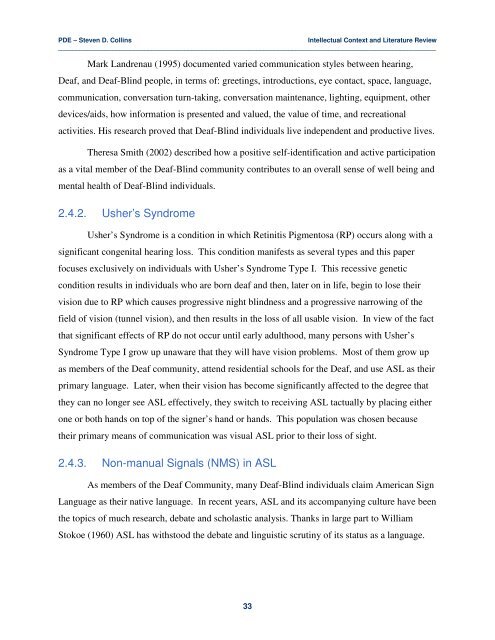Adverbial Morphemes in Tactile ASL - Gallaudet University
Adverbial Morphemes in Tactile ASL - Gallaudet University
Adverbial Morphemes in Tactile ASL - Gallaudet University
Create successful ePaper yourself
Turn your PDF publications into a flip-book with our unique Google optimized e-Paper software.
PDE – Steven D. Coll<strong>in</strong>s<br />
Intellectual Context and Literature Review<br />
_________________________________________________________________________________________________________<br />
Mark Landrenau (1995) documented varied communication styles between hear<strong>in</strong>g,<br />
Deaf, and Deaf-Bl<strong>in</strong>d people, <strong>in</strong> terms of: greet<strong>in</strong>gs, <strong>in</strong>troductions, eye contact, space, language,<br />
communication, conversation turn-tak<strong>in</strong>g, conversation ma<strong>in</strong>tenance, light<strong>in</strong>g, equipment, other<br />
devices/aids, how <strong>in</strong>formation is presented and valued, the value of time, and recreational<br />
activities. His research proved that Deaf-Bl<strong>in</strong>d <strong>in</strong>dividuals live <strong>in</strong>dependent and productive lives.<br />
Theresa Smith (2002) described how a positive self-identification and active participation<br />
as a vital member of the Deaf-Bl<strong>in</strong>d community contributes to an overall sense of well be<strong>in</strong>g and<br />
mental health of Deaf-Bl<strong>in</strong>d <strong>in</strong>dividuals.<br />
2.4.2. Usher’s Syndrome<br />
Usher’s Syndrome is a condition <strong>in</strong> which Ret<strong>in</strong>itis Pigmentosa (RP) occurs along with a<br />
significant congenital hear<strong>in</strong>g loss. This condition manifests as several types and this paper<br />
focuses exclusively on <strong>in</strong>dividuals with Usher’s Syndrome Type I. This recessive genetic<br />
condition results <strong>in</strong> <strong>in</strong>dividuals who are born deaf and then, later on <strong>in</strong> life, beg<strong>in</strong> to lose their<br />
vision due to RP which causes progressive night bl<strong>in</strong>dness and a progressive narrow<strong>in</strong>g of the<br />
field of vision (tunnel vision), and then results <strong>in</strong> the loss of all usable vision. In view of the fact<br />
that significant effects of RP do not occur until early adulthood, many persons with Usher’s<br />
Syndrome Type I grow up unaware that they will have vision problems. Most of them grow up<br />
as members of the Deaf community, attend residential schools for the Deaf, and use <strong>ASL</strong> as their<br />
primary language. Later, when their vision has become significantly affected to the degree that<br />
they can no longer see <strong>ASL</strong> effectively, they switch to receiv<strong>in</strong>g <strong>ASL</strong> tactually by plac<strong>in</strong>g either<br />
one or both hands on top of the signer’s hand or hands. This population was chosen because<br />
their primary means of communication was visual <strong>ASL</strong> prior to their loss of sight.<br />
2.4.3. Non-manual Signals (NMS) <strong>in</strong> <strong>ASL</strong><br />
As members of the Deaf Community, many Deaf-Bl<strong>in</strong>d <strong>in</strong>dividuals claim American Sign<br />
Language as their native language. In recent years, <strong>ASL</strong> and its accompany<strong>in</strong>g culture have been<br />
the topics of much research, debate and scholastic analysis. Thanks <strong>in</strong> large part to William<br />
Stokoe (1960) <strong>ASL</strong> has withstood the debate and l<strong>in</strong>guistic scrut<strong>in</strong>y of its status as a language.<br />
33
















